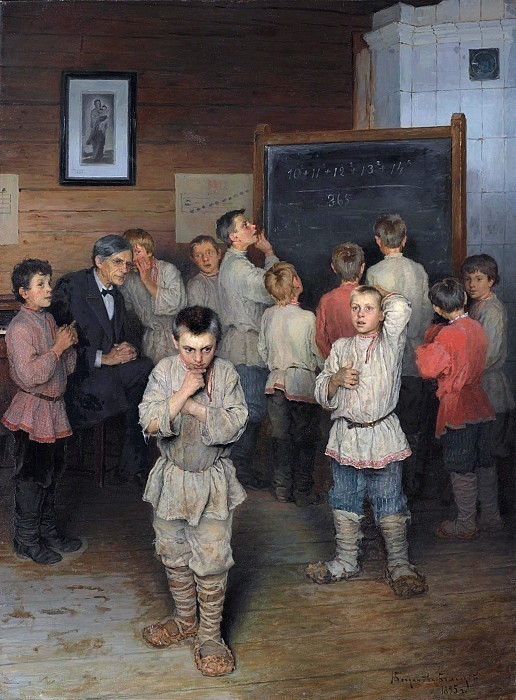Verbal counting. In the folk school of S.A. Rachinsky Nikolai Petrovich Bogdanov-Belsky (1868-1945)
Nikolai Petrovich Bogdanov-Belsky – Verbal counting. In the folk school of S.A. Rachinsky
Edit attribution
Download full size: 1507×2048 px (0,3 Mb)
Painter: Nikolai Petrovich Bogdanov-Belsky
Location: The State Tretyakov Gallery, Moscow (Государственная Третьяковская галерея).
The famous Russian artist Nikolai Petrovich Bogdanov-Belsky painted a unique and incredibly vital story in 1895. The work is called "Oral Counting," and in the full version "Oral Counting. In the People’s School of S. A. Rachinsky." Painted in oil on canvas, the painting depicts a 19th-century rural school during an arithmetic class. The students are solving an interesting and difficult example.
Description of the painting "Oral Counting" by Nikolai Bogdanov Belsky
The famous Russian artist Nikolai Petrovich Bogdanov-Belsky painted a unique and incredibly vital story in 1895. The work is called "Oral Counting," and in the full version "Oral Counting. In the People’s School of S. A. Rachinsky."
Painted in oil on canvas, the painting depicts a 19th-century rural school during an arithmetic class. The students are solving an interesting and difficult example. They are in deep thought and searching for the right solution. Some are thinking at the board, some are standing off to the side and trying to match knowledge that will help in solving the problem. The children are completely absorbed in finding the answer to the question posed; they want to prove to themselves and the world that they can do it.
Nearby stands the teacher, the prototype of which is the famous botanist and mathematician Rachinsky himself. Not for nothing the picture is given such a name, it is in honor of the professor of Moscow University. The painting depicts 11 children and only one boy whispers quietly in the teacher’s ear, perhaps the correct answer.
The picture shows a simple Russian class, the children are dressed in peasant clothing: sandals, pants and shirts. All this is very harmoniously and succinctly fits into the subject, unobtrusively conveying to the world the desire for knowledge on the part of ordinary Russian people.
The warm color scheme brings kindness and simplicity of the Russian people, there is no envy and falsehood, no evil and hatred, children from different families with different incomes gathered together to make the only right decision. This is very lacking in our modern lives, where people are used to live very differently, not taking into account the opinions of others.
Nikolai Petrovich dedicated the picture to his teacher, a great mathematical genius, whom he knew and respected well. Now the picture is in Moscow in the Tretyakov Gallery, will be there, be sure to look at the great master’s pen.
Кому понравилось
Пожалуйста, подождите
На эту операцию может потребоваться несколько секунд.
Информация появится в новом окне,
если открытие новых окон не запрещено в настройках вашего браузера.
You need to login
Для работы с коллекциями – пожалуйста, войдите в аккаунт (open in new window).














COMMENTS: 1 Ответы
Кто о чём мыслит, а в глазах огонь. Красота.
You cannot comment Why?
The painting depicts a classroom scene in a rural folk school, likely in Russia during the late 19th century given the artists signature 1895. A teacher, dressed in a formal dark suit and bow tie, sits to the left, observing a group of young boys gathered around a blackboard. The boys are dressed in simple, traditional clothing, indicating their humble origins.
On the blackboard, a mathematical problem is written: 10+11+12+13+14 and below it, 365. A few boys are actively engaged with the problem, with one boy pointing at the blackboard and another looking intently at it. The overall atmosphere seems to be one of focused learning, but with hints of playful distraction and perhaps some apprehension among the students.
The subtexts of the painting are rich and multifaceted:
In essence, the painting captures a specific moment of learning in a folk school, offering a glimpse into the lives of rural children and the educational aspirations of their time, while also exploring themes of individual effort, social realities, and the democratizing power of knowledge.